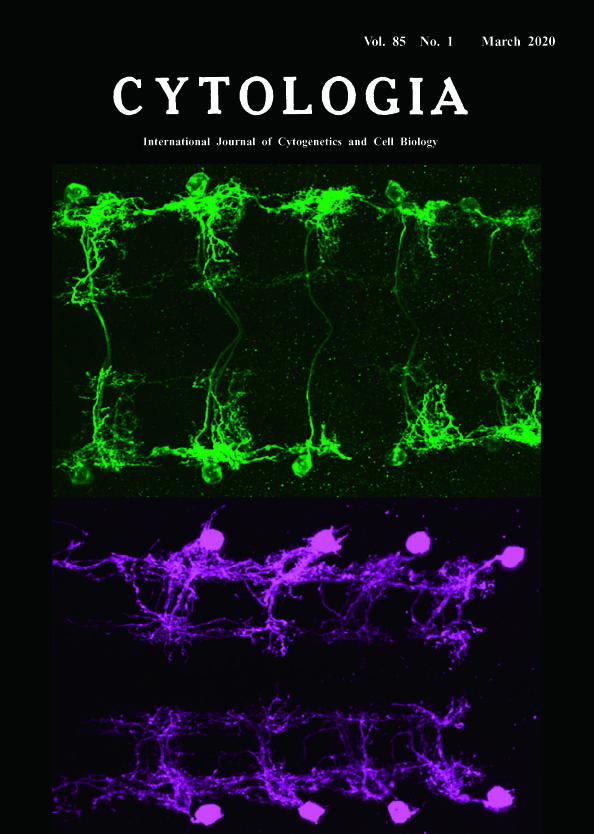| ON THE COVER |  |
|
|---|---|---|
| Vol. 85 No.1 March 2020 | ||
| Technical Note | ||
|
|
||
Interneurons for Specific Animal Behavior Hiroshi Kohsaka1* and Akinao Nose1,2 1 Department of Complexity Science and Engineering, Graduate School of Frontier Sciences, the University of Tokyo, 5–1–5 Kashiwanoha, Kashiwa, Chiba 277–8561, Japan 2 Department of Physics, Graduate School of Science, the University of Tokyo, 7–3–1 Hongo, Bunkyo-ku, Tokyo 133–0033, Japan Received October 25, 2019; accepted November 19, 2019 An animal exhibits multiple patterns of motion. Distinct motor patterns are generated by different spatiotemporal activity in the neural circuits. Recent progresses in genetic tools enable us to analyze circuit mechanisms underlying the spatiotemporal neural activity in a cellular level. The crawling behavior of fly larvae (Drosophila melanogaster) is one of the useful model systems to analyze the mechanisms of motor pattern generation in a cellular level (Kohsaka et al. 2012). Fly larvae show two types of crawling, namely forward crawling and backward crawling. By using genetic tools including calcium imaging and optogenetics, several interneurons involved in crawling behavior have been identified (Matsunaga et al. 2013, Kohsaka et al. 2014, 2017). Panels on the cover show two interneurons for specific larval behavior (Kohsaka et al. 2019). The images are magnified ×1000, the distance between neurons in neighboring segments is about 40 μm. Ifb-Fwd interneurons (the upper panel, green) and Ifb-Bwd interneurons (the bottom panel, magenta) were labeled by a membrane-bound form GFP expressed by split Gal4 transgenes SS02065 (R32C05-p65ADzp, R38E10- ZpGDBD) and SS026694 (VT020818-p65ADzp, R91E03-ZpGDBD), respectively. The AD (activation domain) and DBD (DNA binding domain) are fused through a leucine zipper to form a transcription factor equivalent to Gal4. This intersection technique can narrow down the number of the labeled neurons. Immunohistochemistry was performed in the 3rd instar larvae (about 4 mm in length). Put a larva on a sylgard coated dish, dorsal side up and pin down with insect pins (Austerlitz Insect pins, Φ 0.10 mm, stainless). Cut along the dorsal midline with micro scissors (MB-50-7, Napox, Japan). Remove the internal organs except for the CNS (about 0.4 mm in length). Fix the dissected larvae with 3.7% formaldehyde for 30 min at room temperature, washing with 0.2% Triton X-100 in PBS for 30 min at room temperature, blocking with normal goat serum for 30 min at room temperature and staining with the following antibodies at 4°C overnight each. Primary antibody: rabbit anti-GFP (Frontier science, Af2020 1 : 1000). Secondary antibody: Alexa488 goat anti-rabbit (Invitrogen, 1 : 500). The images were obtained by confocal microscope (FV1000, Olympus). Ifb-Fwd interneurons are activated during forward crawling but not in backward crawling. In contrast, Ifb- Bwd neurons fire only in backward but not in forward crawling. These two neurons are specialized for specific behavior. To study a circuit mechanism to generate crawling behavior, the circuit downstream of Ifb-Fwd and Ifb-Bwd neurons was investigated. The circuit diagram shows that Ifb-Fwd and Ifb-Bwd innervate a common set of premotor interneurons. Consequently, while Ifb-Fwd and Ifb-Bwd are specialized for specific behavior, they drive the same downstream motor circuit, which imply that distinct behavior can be economically encoded in the nervous system by sharing a small sub-circuit.
Kohsaka, H., Guertin, P. A. and Nose, A. 2017. Neural circuits underlying fly larval locomotion. Curr. Pharm. Des. 23: 1722–1733. Kohsaka, H., Okusawa, S., Itakura, Y., Fushiki, A. and Nose, A. 2012. Development of larval motor circuits in Drosophila. Dev. Growth Differ. 54: 408–419. Kohsaka, H., Takasu, E., Morimoto, T. and Nose, A. 2014. A group of segmental premotor interneurons regulates the speed of axial locomotion in Drosophila larvae. Curr. Biol. 24: 2632–2642. Kohsaka, H., Zwart, M. F., Fushiki, A., Fetter, R. D., Truman, J. W., Cardona, A. and Nose, A. 2019. Regulation of forward and backward locomotion through intersegmental feedback circuits in Drosophila larvae. Nat. Commun. 10: 2654. Matsunaga, T., Fushiki, A., Nose, A. and Kohsaka, H. 2013. Optogenetic perturbation of neural activity with laser illumination in semi-intact Drosophila larvae in motion. J. Vis. Exp. 77: e50513. * Corresponding author, e-mail:kohsaka@edu.k.u-tokyo.ac.jp DOI: 10.1508/cytologia.85.1 0 |
||